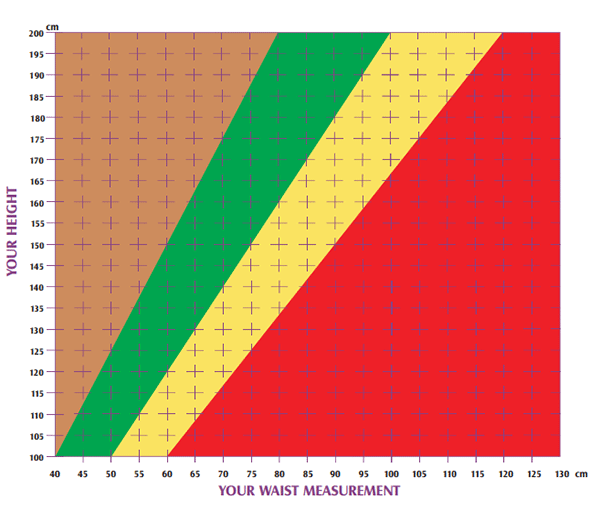Waist to Height Ratio Calculator
Experts are now claiming that your Waist/Height Ratio (WHtR) is a far more accurate way of measuring healthy weight than the traditional Body Mass Index (BMI). Not to be confused with your Waist/Hip Ratio (WHR), your WHtR calculates your body fat distribution and can be a significant early indicator of risk of diabetes, heart disease and stroke.
The calculation is equally valid for children as it is for adults.
Healthy Weight to Height Ratio
To measure the WHtR, simply record waist circumference, then divide that number by height.
- WHtR > 0.5
Higher risk of diabetes, heart disease, stroke and lower life span - WHtR < 0.5
Considered healthy for both men and women worldwide
BMI Shortcomings
BMI is measured by a person’s weight in kilograms divided by the square of their height in meters – it is a complicated calculation and the formula is unfamiliar to most people. More importantly, the BMI doesn’t make allowances for the distribution of fat around the body.
Visceral Fat
Recently British scientists have revealed that a typical ‘apple’ shaped person, who carries excess abdominal fat (which sits close to the heart, liver and kidneys) is at far greater risk of health issues than a pear-shaped person, who typically carries weight on the hips, thighs and bottom.
Measuring someone’s waist is fundamental because it accounts for critical levels of fat that accumulate in between internal organs and the torso, aka visceral fat or ‘central obesity’. Visceral fat is directly linked to strokes and heart disease.
Example
Essentially: your waist should measure no more than half the length of your height
For a 6ft man (72 inches), this means having a waistline no larger than 36 inches, while a 5ft 4in (64 inch) woman’s waist should measure 32in or less. For people under the age of 40, a WHtR of over 0.50 is considered to put them at critical risk. For the over fifties the critical values start at 0.60.
Waist to Height Ratio Chart
This Ashwell made and copyrighted chart is designed for male and female adults and children over five years (1).
 Waist to Height Ratio Chart
Waist to Height Ratio Chart
The base contains waist circumference measurements in the form of centimeters (x axis). The opposite side focuses on height measurements also measured in centimeters (y axis).
The boundary description values for this chart are set in relation to WHtR;
- 0.4 (brown to green) meaning the waist circumference measures less than half your height
- 0.5 (green to yellow) meaning the waist circumference should be less than or equal to your height
- 0.6 (yellow to red) was chosen to show the waist measurements are above your height
The brown section indicates no need for weight loss or decreasing in waist circumference measurements, patient may be underweight. Green area is ok and ideal. Yellow means the patient should consider taking action in the case of adults and children. Red also indicates a need for immediate action.
Longer Lifespan
Another of the focuses of the study was on the accurate prediction of lifespan. It demonstrated that people with the highest WHtRs (whose waistlines measured 80% that of their height), lived on average 17 years less than their lower WHtR counterparts (2).
Dr Ashwell has also recommended that WHtR should be considered for use as a valuable screening tool, particularly for children as young as five, who are showing initial signs of excess weight gain, or whose lifestyle or heritage puts them at greater risk of obesity.
If you’re wondering what your personal WHtR is and if you fall within ‘safe’ limits, why not input your details into the handy interactive calculator above?